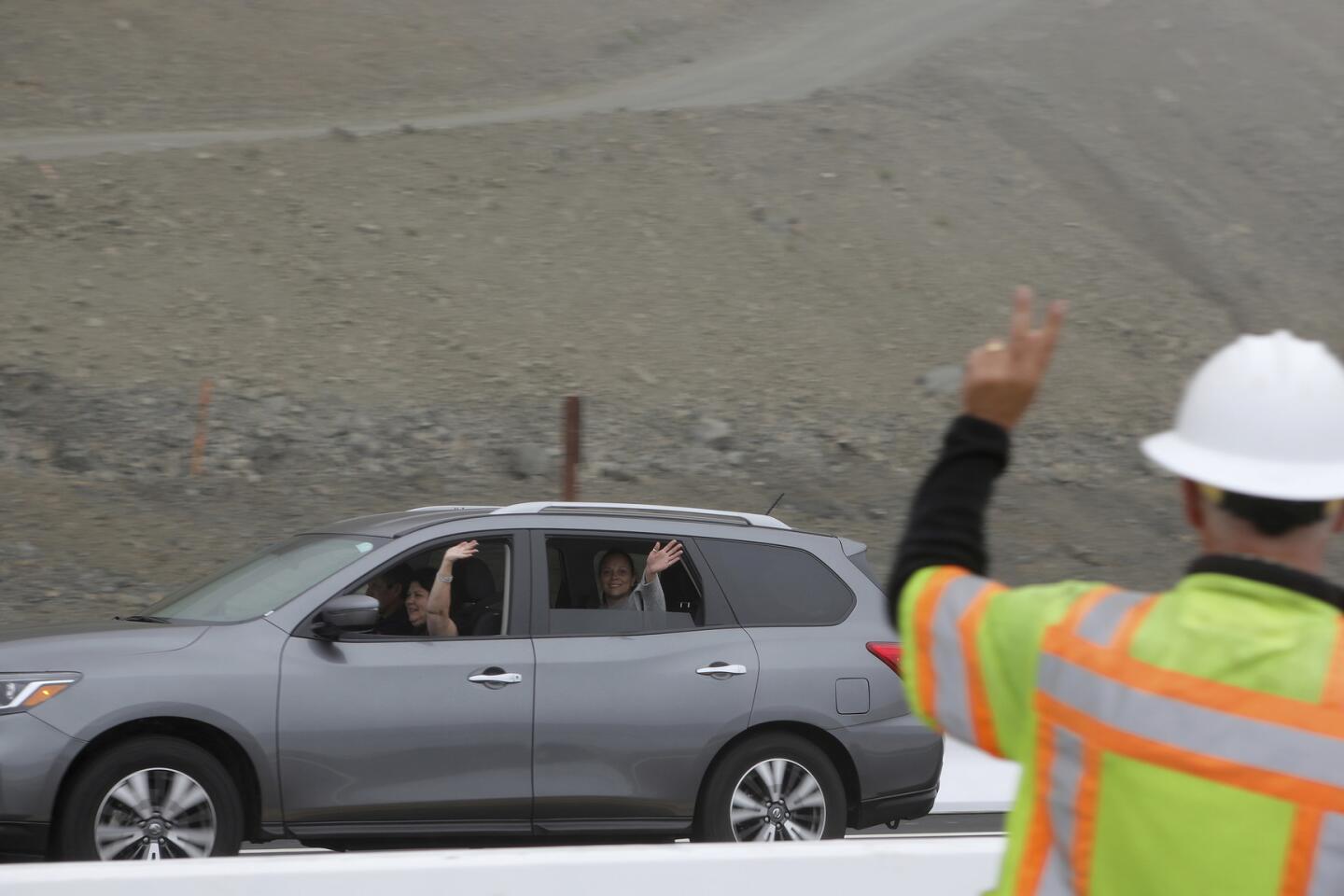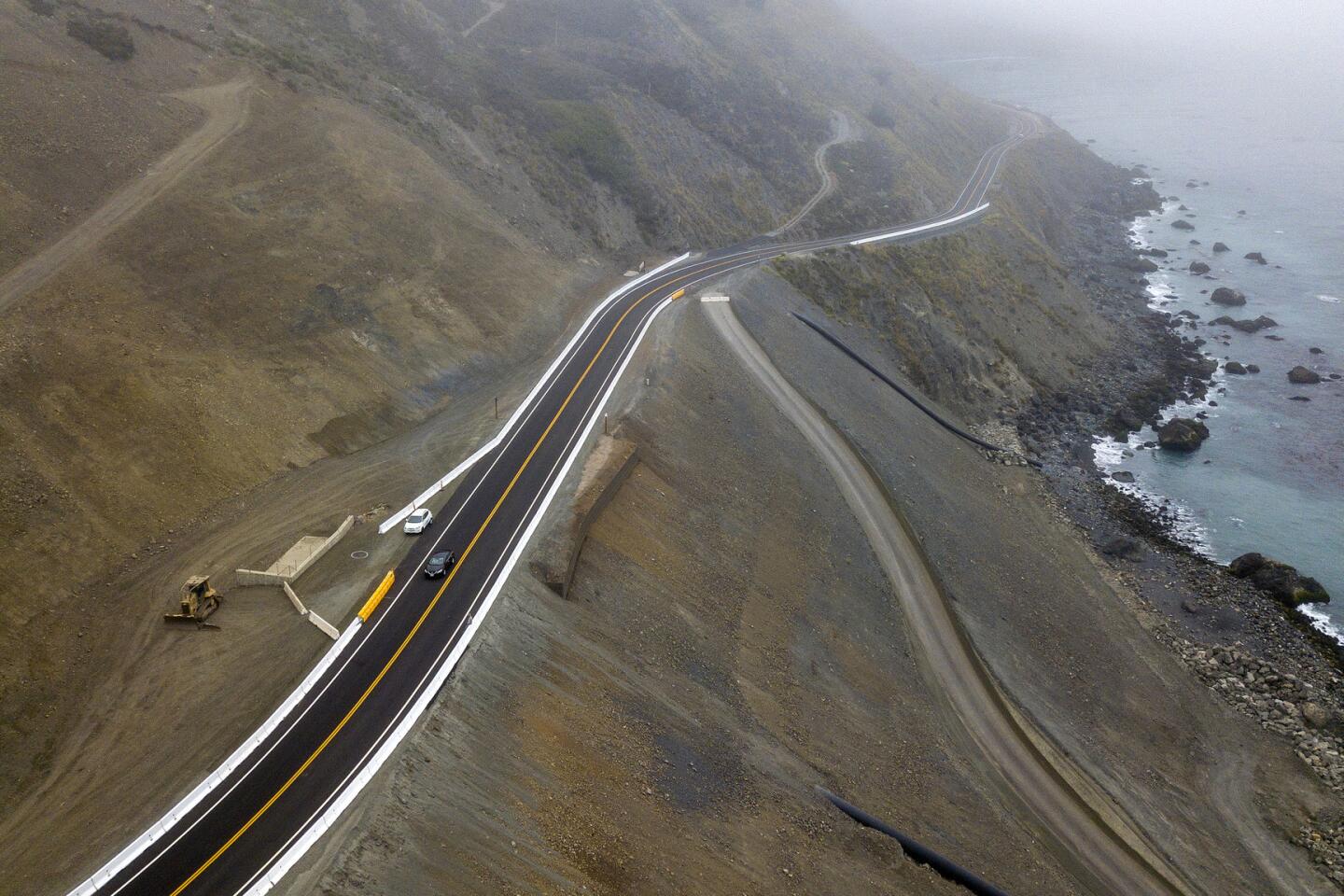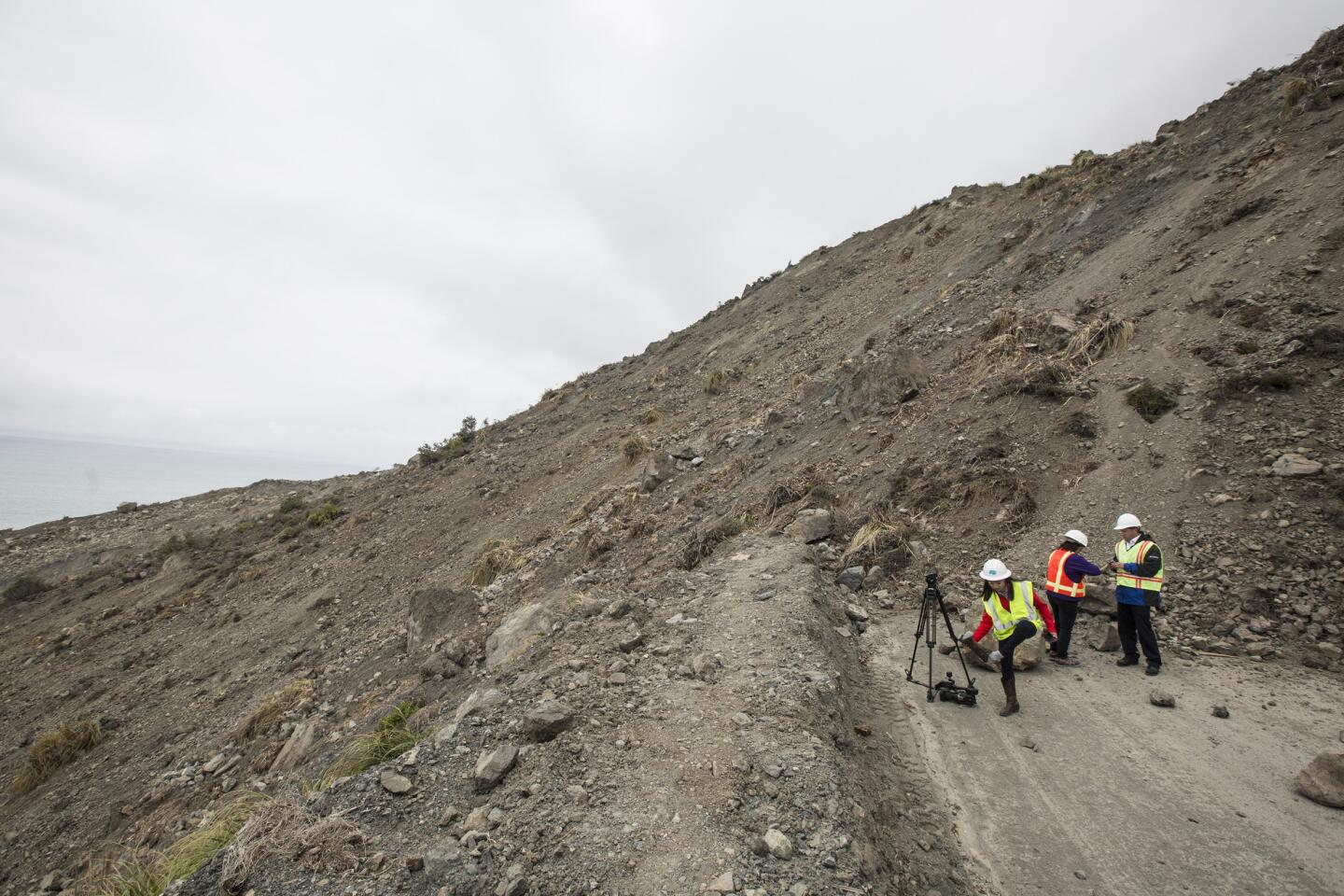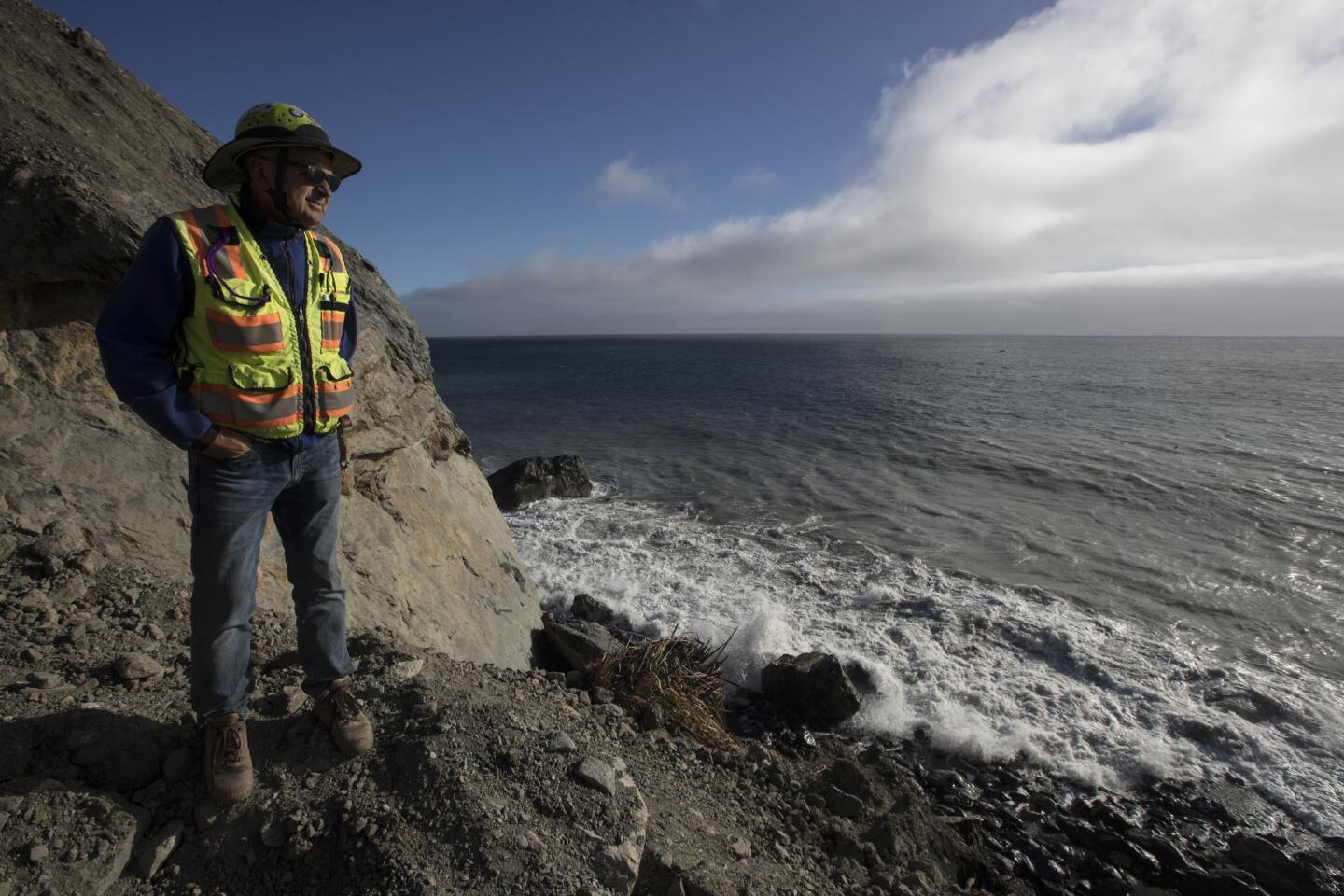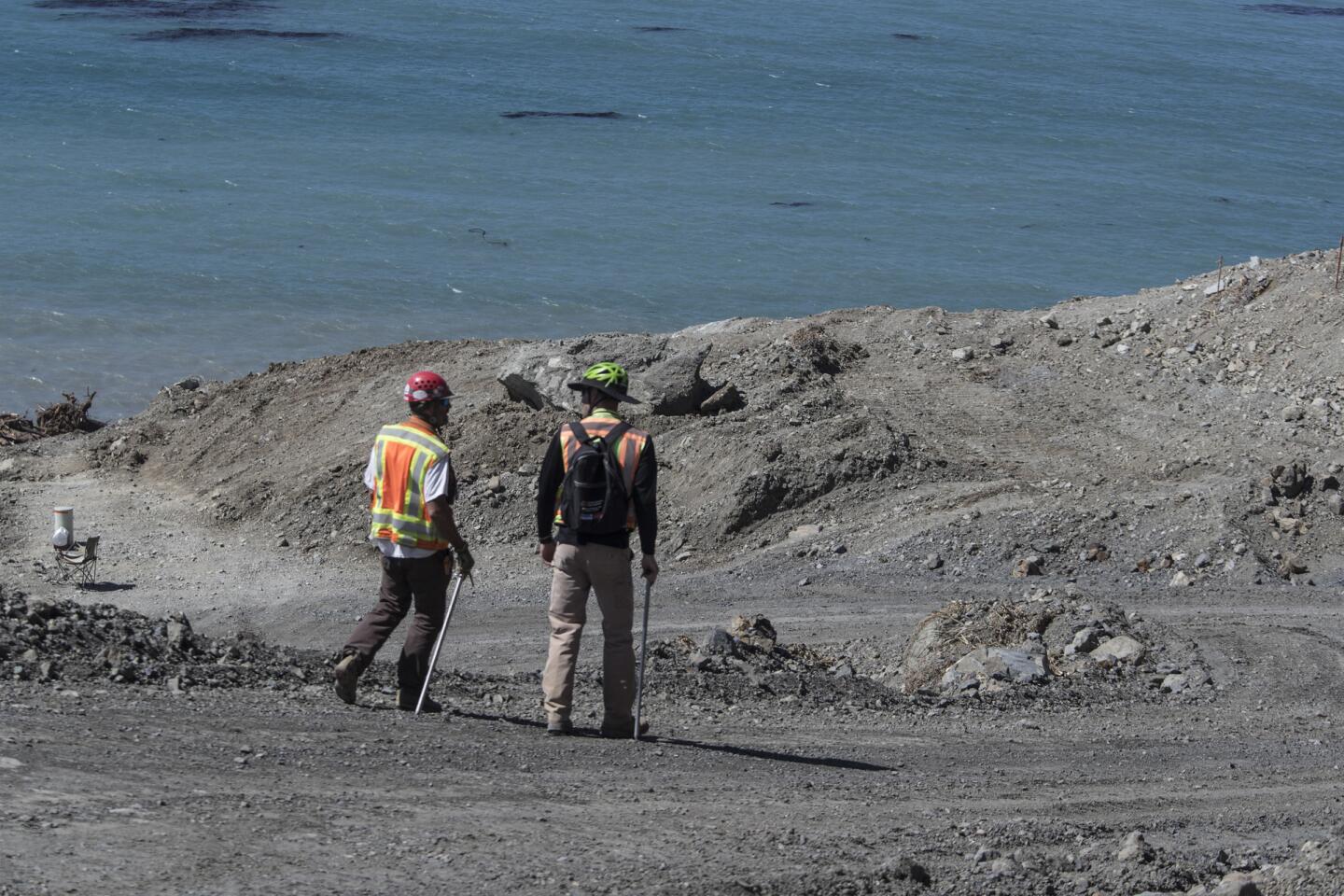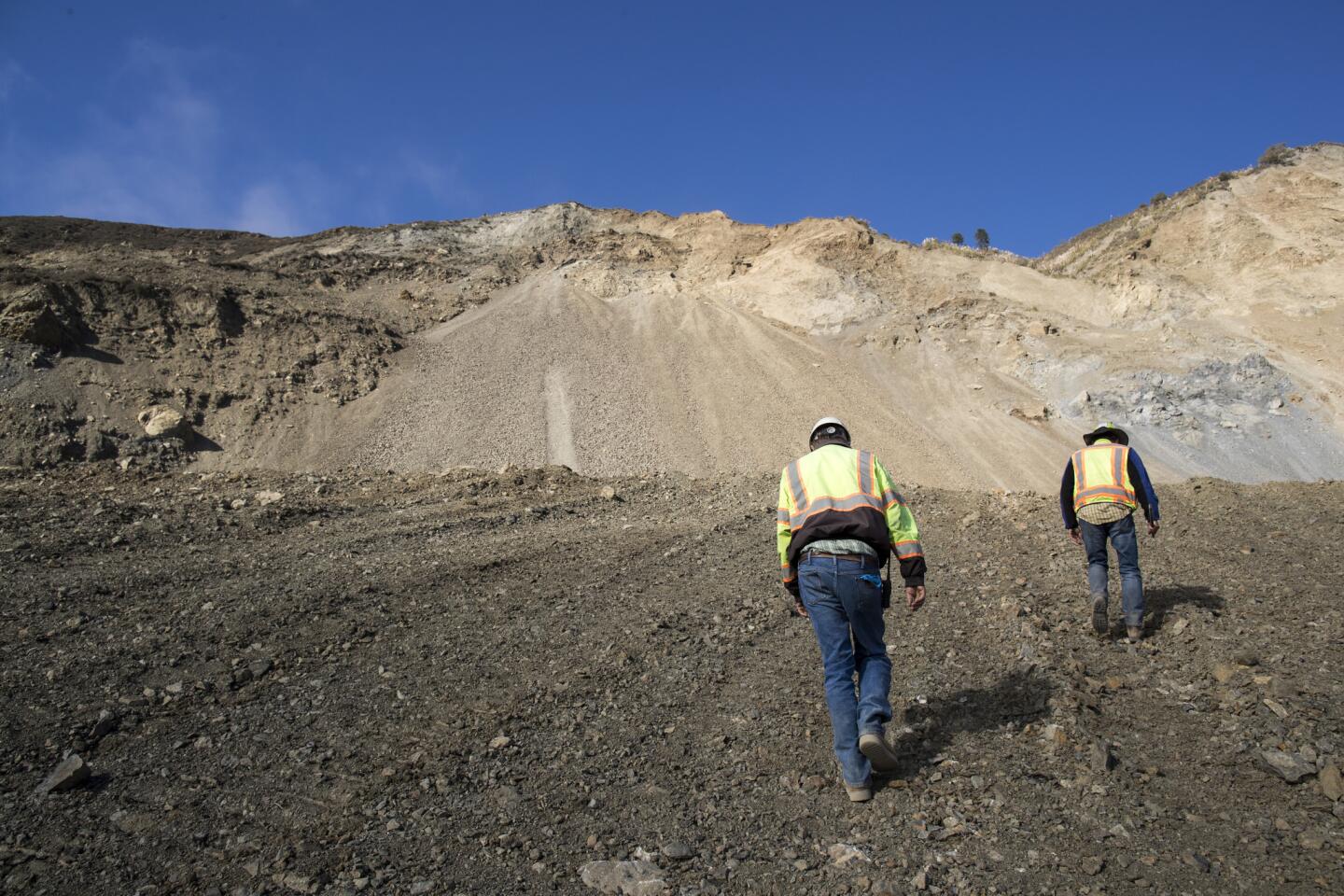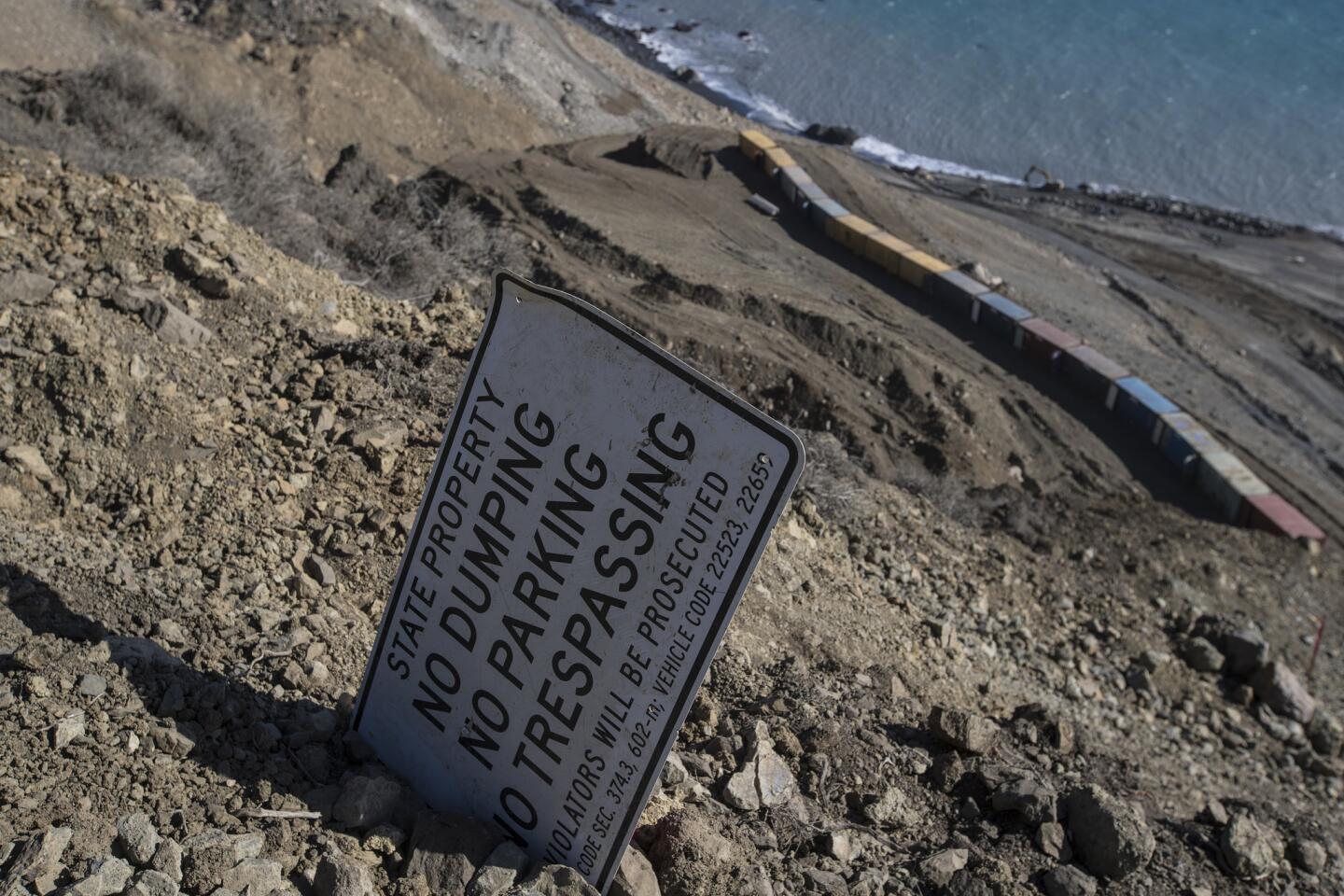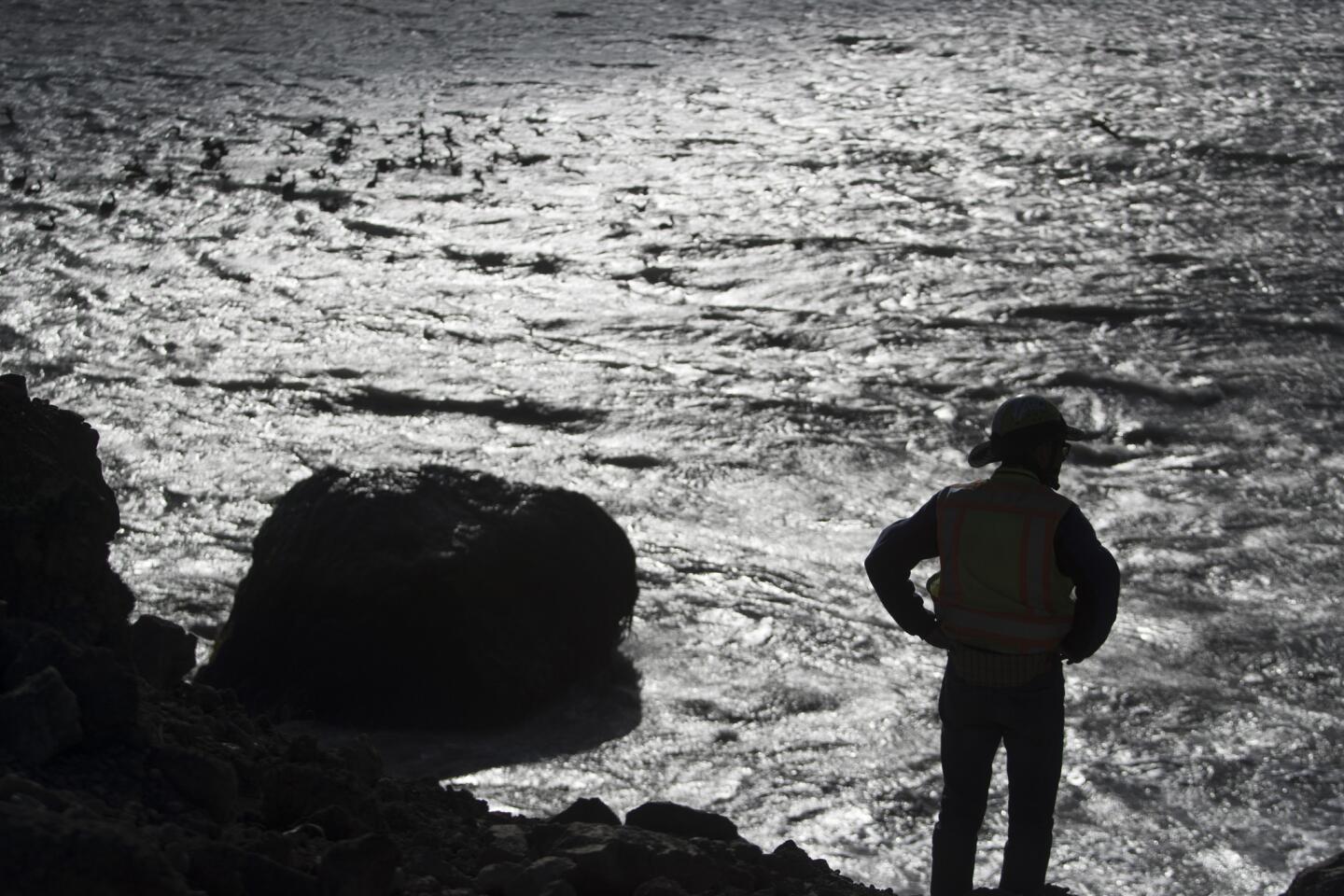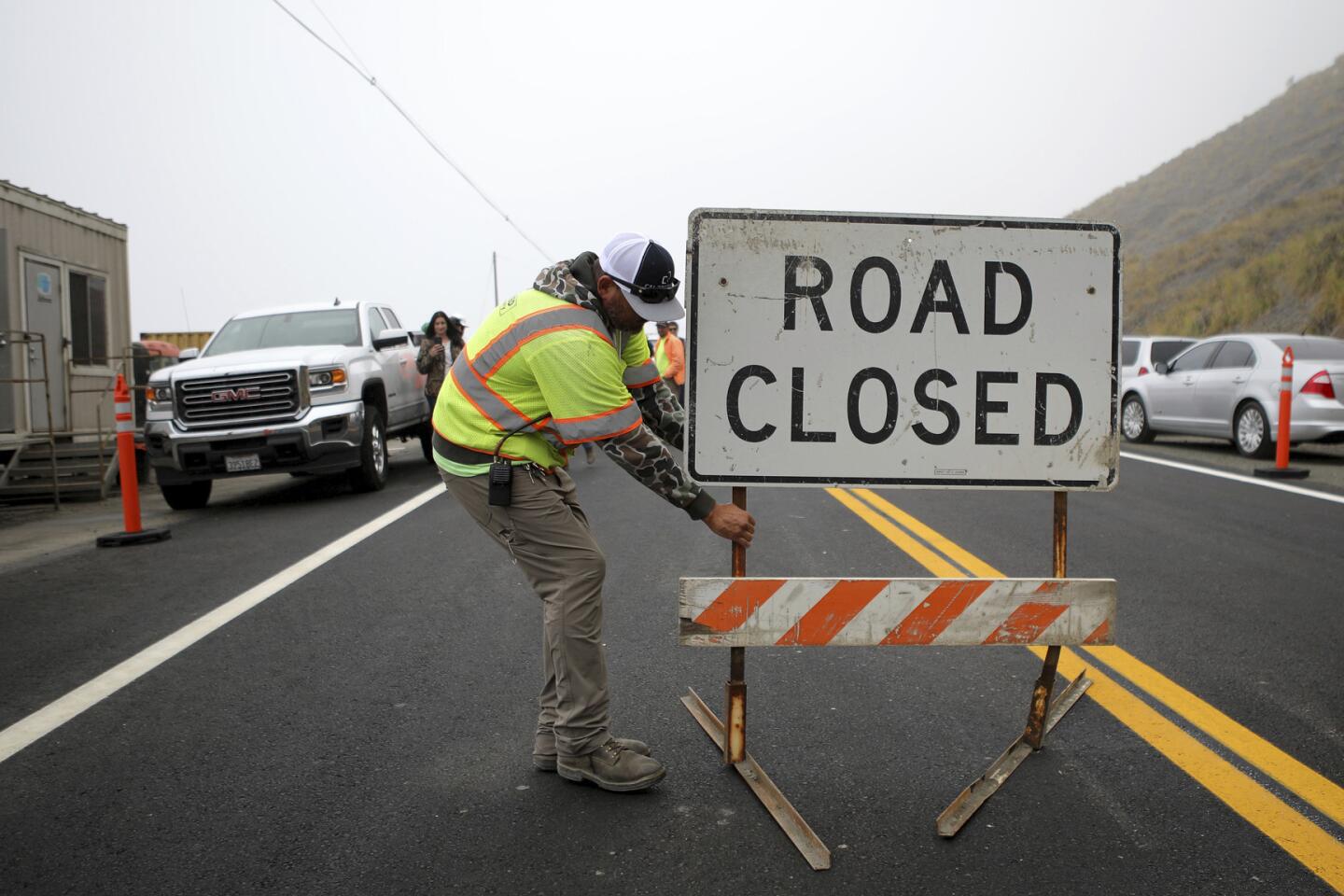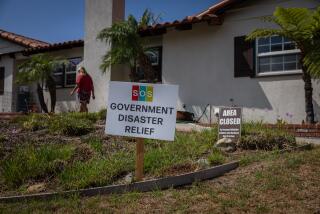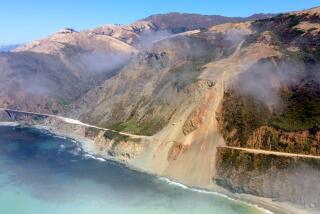Must Reads: ‘Monumental’ undertaking: Workers finally tame an epic landslide that reshaped the coast and blocked Highway 1
Drivers along Highway 1 — coming and going to Big Sur — typically ignored Mud Creek. Most maps overlooked this most prosaically named feature along the California coast.
There were no landmarks here, nothing to call attention to anything but the road, which hugged a cliff high above the surf below. To do otherwise would invite tragedy.
Yet in matters of California geology, nothing is too modest to be remarkable.
Last year Mud Creek roared into life when it channeled one of the state’s largest landslides in recent history, severing Highway 1 for a quarter mile and presenting dozens of engineers, geologists and construction crews the greatest challenge of their careers.
For 14 months, they devoted themselves to reopening this iconic route, and Wednesday, culminating an arduous schedule of 12-hour days, seven days a week, they allowed themselves to celebrate.
At 9:45 a.m., Caltrans made a final inspection, opened the barricades and began to let traffic pass through this stretch of Highway 1.
“I’ve worked on many landslides,” said engineering geologist John Duffy, who has been involved with nearly 200 road repairs throughout the state, “but this was the biggest one for sure. It’s been a real challenge and — not to sound like an ambulance chaser — it has been very exciting.”
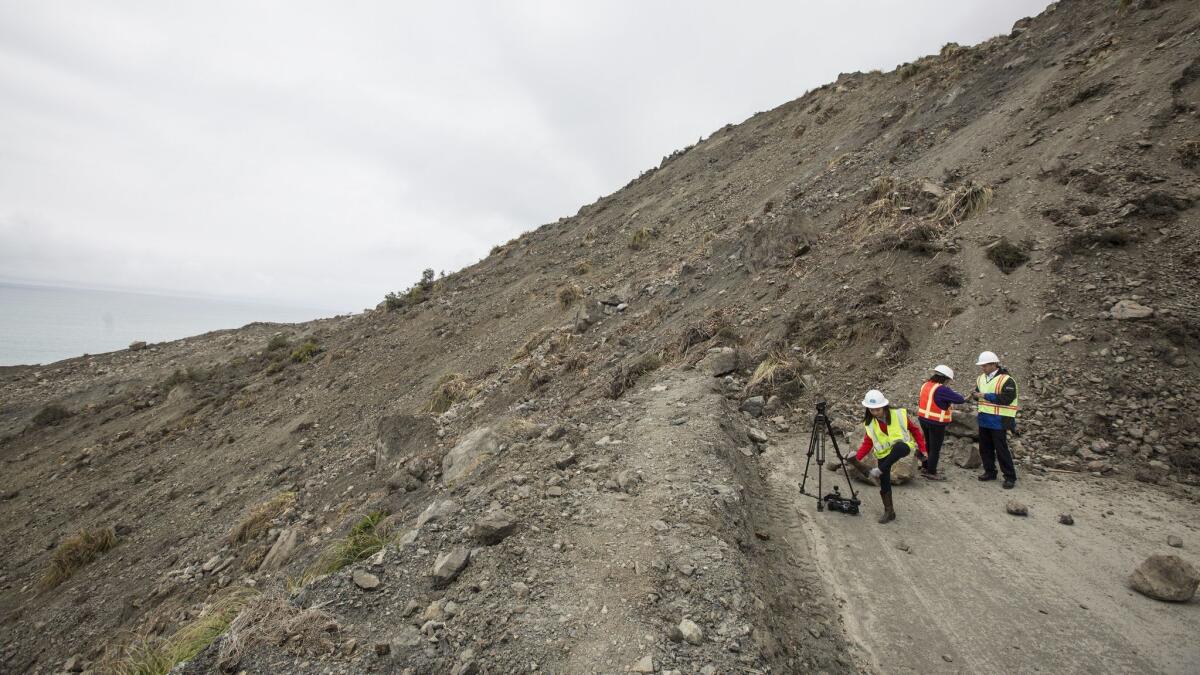
A monumental project
Nearly 40 cars, coming from the north and south, streamed across the new ribbon of asphalt Wednesday morning, protected by embankments, berms, netting and culverts. Although the highway — with two 12-foot lanes and two 4-foot shoulders — is designed for 55 mph, the cars moved at a slower crawl because of thick fog.
“This has been a monumental project,” said John Madonna, whose construction company has been on site for nearly 17 months. “I would put working on the Mud Creek slide in the same category as the Empire State Building and the Golden Gate Bridge.”
“Those who were able to make this commitment for the last year and a half feel fortunate to be part of something bigger than all of us,” he said.
With the reopening of Highway 1 at Mud Creek, Caltrans can close the books on damage inflicted upon this road by the winter storms of 2017.
After 17 months and more than $100 million replacing a damaged bridge and rebuilding the highway in two locations, drivers can once again skirt the western edge of the continent, forever burnished by wind, rain, waves and tide.
83 inches of rain, and then some
The onslaught began President’s Day weekend 2017, and within a week, Caltrans was fighting three major fronts along this storied route.
Epic deluges — by mid-winter up to 83 inches of rain had been reported at one station — undermined the Pfeiffer Canyon Bridge in Big Sur. It was soon closed and condemned, the community of Big Sur divided.
Having endured the disastrous Soberanes fire in 2016, residents took to gallows humor. Stan Russell of the Big Sur Chamber of Commerce remembers thinking at the time, “When are the locusts showing up?”
Farther south, pounding rains had sent a steady stream of water, rocks and mud onto the highway in the vicinity of Limekiln State Park.
At one stretch known as Paul’s Slide, the southbound lanes collapsed, undermined by the water running beneath the road. This was at the end of February, and engineers hoped it would be the worst. They were already stretched thin and under pressure from the community in Big Sur.
“It was gut-wrenching,” said Alicia Hahn, manager of the restaurant at Nepenthe, a well-known detour for travelers, that was cut off from the north and south. “We had 117 employees. All of the sudden we had all these people out of work.”
Then on the night of May 20, Mud Creek became an elevator chute, channeling more than 5 million cubic yards of rocks and mud over the highway, adding nearly 15 acres to the coast. By one estimate, the volume of material was enough to fill the Rose Bowl seven times.
“This is a big one,” said one engineer not inclined to hyperbole.
For those who remembered, the benchmark for catastrophic slides along the coast had always been an event which took place in 1983 near Julia Pfeiffer Burns State Park. That slide dropped 2 million cubic yards of rocks and dirt onto the highway and kept it closed for more than a year.
A land of landslides
The Santa Lucia Mountains, the coastal range from Cambria to Carmel, have always been vulnerable to the capriciousness of nature. They are among the weakest geological structures in the state.
Geologists frequently describe the bedrock here as “tortured” for having been pulverized through the subduction of the tectonic plates — the Farallon and North American — that formed this side of North America.
When the California Geological Survey studied 73 miles of the coast in 2001, they counted 1,404 landslides, both dormant and active.
Debris flows scour the surface of these steep hillsides, and the movement of groundwater compromises the deeper subsurface structures of earth, so that the earth can continue to move well after the rains have stopped.
“Working out here is like Groundhog Day,” said Ryan Turner, a geotechnical engineer with Caltrans. “Each day crews are repeating the steps of the previous day just to stay even with the ongoing damage.”
After Mud Creek exploded, meetings were hastily called. Geologists and engineers knew the urgency of their task.
Not only were scores of businesses and residences dependent on the highway for their livelihood, but tourists considered this route between San Luis Obispo and Carmel with religious devotion.
During its peak, Highway 1 can typically carry 3,000 vehicles a day to the resorts, art galleries, hotels and restaurants of Big Sur.
When the Pfeiffer Canyon Bridge opened in October, the community was reunited. The local economy puttered along at half capacity, Russell said, and residents and tourists, driving in from Carmel, had access as far south as Gorda, where Caltrans had raised barricades.
Meanwhile at Mud Creek, work roads had been tentatively cut into the slide. Sixteen shipping containers — each holding three K-rails — were positioned above the site as protection from falling debris.
Unable to excavate the route of the old highway, the engineers and geologists had decided instead to build the new highway over the slide itself. It was a novel approach: After the 1983 slide, debris was shoveled into the ocean, a strategy that changed the landscape and was criticized for being too intrusive.
The new road at Mud Creek, the engineers realized, needed to be protected from the mountain above and the ocean below. Drawing upon data from satellites, radar, drilling samples and computer models, they came up with a plan that was conceptually simple but challenging to execute.
A catch-basin hundreds of feet above the road was cleared and lined with retaining walls that would catch debris falling from the mountain. A long breakwater, known as a revetment, was constructed along the base of the slide to dispel the force of the waves and minimize erosion.
The result, Duffy said, is the perfect blend of disciplines.
“You can map the progress of science, engineering and technology if you look at how slides are repaired over time,” he said. “Mud Creek is the latest chapter in that history.”
Aided by a mild winter — only one major storm bringing 4 inches of rain — the work progressed smoothly. Initial timeframes had placed the opening of the highway in late September.
Madonna estimateshis company had 30 to 50 workers on site daily, a commitment that required many to “put their lives on hold.” Many had to drive in from San Luis Obispo where they lived.
“Working 12-hour days and commuting up to 90 minutes one way doesn’t leave much time for anything but eating and sleeping,” he said. “A lot of people can’t handle it.”
In Big Sur, news of the opening was celebrated at Nepenthe and at Ventana resort. Hotels and restaurants have already begun putting out “We are hiring” signs, Russell said.
“Everyone is talking about it,” said Kristina Jetton, Ventana’s general manager. “We can hardly believe it because we were so skeptical it was going to happen.”
Hahn is looking forward to making the drive. “I have very dear friends in Cambria,” she said. Reunions had to be held in Santa Barbara or San Luis Obispo. She now looks forward to the one-hour drive down the coast.
The control of nature
Mud Creek today is mostly a scarred and denuded hillside with a modern highway running across it. As vegetation begins to cover its slopes, drivers will be inclined to speed past this historic site.
But for those who chose to stop, Caltrans has placed a small wooden bench on the shoulder of the southbound lanes, just south of the slide. From here, 14 months of engineering design and construction can be appreciated at a glance.
Carved into the bench beneath the Caltrans logo and the initials for John Madonna Construction is the phrase, “Thx John, Mark, Augie & Co.” It is a nod to the primary construction managers on site and a reminder of the efforts to control the ever-changing geology of the California coast.
Times Staff Writers Ben Oreskes and Joseph Serna contributed to this report.
Twitter: @tcurwen
Times Staff Writers Ben Oreskes and Joseph Serna contributed to this report.
Twitter: @tcurwen
More to Read
Sign up for Essential California
The most important California stories and recommendations in your inbox every morning.
You may occasionally receive promotional content from the Los Angeles Times.
